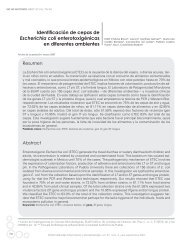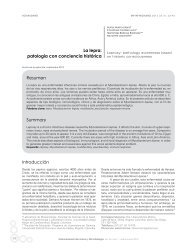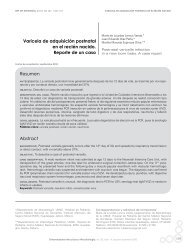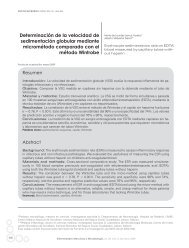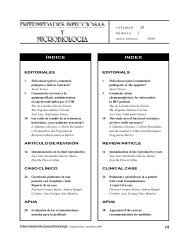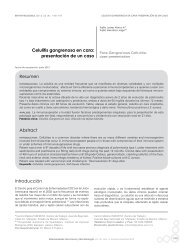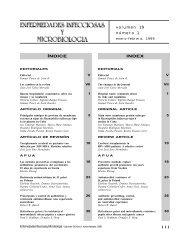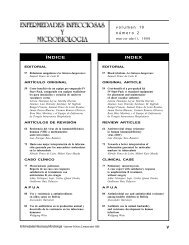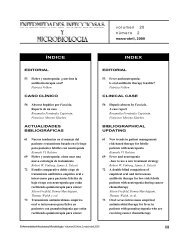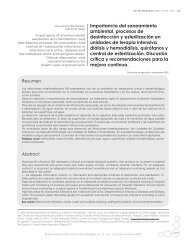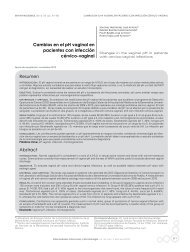treatment of typhoid fever Current concepts in the diagnosis and
treatment of typhoid fever Current concepts in the diagnosis and
treatment of typhoid fever Current concepts in the diagnosis and
Create successful ePaper yourself
Turn your PDF publications into a flip-book with our unique Google optimized e-Paper software.
Downloaded from bmj.com on 30 March 2008<br />
<strong>Current</strong> <strong>concepts</strong> <strong>in</strong> <strong>the</strong> <strong>diagnosis</strong> <strong>and</strong><br />
<strong>treatment</strong> <strong>of</strong> <strong>typhoid</strong> <strong>fever</strong><br />
Zulfiqar A Bhutta<br />
BMJ 2006;333;78-82<br />
doi:10.1136/bmj.333.7558.78<br />
Updated <strong>in</strong>formation <strong>and</strong> services can be found at:<br />
http://bmj.com/cgi/content/full/333/7558/78<br />
Data supplement<br />
References<br />
Rapid responses<br />
Email alert<strong>in</strong>g<br />
service<br />
These <strong>in</strong>clude:<br />
"Extra references"<br />
http://bmj.com/cgi/content/full/333/7558/78/DC1<br />
This article cites 20 articles, 4 <strong>of</strong> which can be accessed free at:<br />
http://bmj.com/cgi/content/full/333/7558/78#BIBL<br />
2 onl<strong>in</strong>e articles that cite this article can be accessed at:<br />
http://bmj.com/cgi/content/full/333/7558/78#o<strong>the</strong>rarticles<br />
2 rapid responses have been posted to this article, which you can access for<br />
free at:<br />
http://bmj.com/cgi/content/full/333/7558/78#responses<br />
You can respond to this article at:<br />
http://bmj.com/cgi/eletter-submit/333/7558/78<br />
Receive free email alerts when new articles cite this article - sign up <strong>in</strong> <strong>the</strong><br />
box at <strong>the</strong> top left <strong>of</strong> <strong>the</strong> article<br />
Notes<br />
To order repr<strong>in</strong>ts follow <strong>the</strong> "Request Permissions" l<strong>in</strong>k <strong>in</strong> <strong>the</strong> navigation box<br />
To subscribe to BMJ go to:<br />
http://resources.bmj.com/bmj/subscribers
Downloaded from bmj.com on 30 March 2008<br />
Cl<strong>in</strong>ical review<br />
<strong>Current</strong> <strong>concepts</strong> <strong>in</strong> <strong>the</strong> <strong>diagnosis</strong> <strong>and</strong> <strong>treatment</strong> <strong>of</strong><br />
<strong>typhoid</strong> <strong>fever</strong><br />
Zulfiqar A Bhutta<br />
Department <strong>of</strong><br />
Paediatrics <strong>and</strong><br />
Child Health, Aga<br />
Khan University,<br />
Karachi, Pakistan<br />
Zulfiqar A Bhutta<br />
Huse<strong>in</strong> Lalji Dewraj<br />
pr<strong>of</strong>essor <strong>and</strong><br />
chairman<br />
zulfiqar.bhutta@<br />
aku.edu<br />
BMJ 2006;333:78–82<br />
Although advances <strong>in</strong> public health <strong>and</strong> hygiene have<br />
led to <strong>the</strong> virtual disappearance <strong>of</strong> enteric <strong>fever</strong> (more<br />
commonly termed <strong>typhoid</strong> <strong>fever</strong>) from much <strong>of</strong> <strong>the</strong><br />
developed world, <strong>the</strong> disease rema<strong>in</strong>s endemic <strong>in</strong> many<br />
develop<strong>in</strong>g countries. Typhoid <strong>fever</strong> is caused by<br />
Salmonella enterica serovar Typhi (S typhi), a Gram<br />
negative bacterium. A similar but <strong>of</strong>ten less severe<br />
disease is caused by S paratyphi A <strong>and</strong>, less commonly,<br />
by S paratyphi B (Schotmulleri) <strong>and</strong> S paratyphi C (Hirschfeldii).<br />
The common mode <strong>of</strong> <strong>in</strong>fection is by <strong>in</strong>gestion<br />
<strong>of</strong> an <strong>in</strong>fect<strong>in</strong>g dose <strong>of</strong> <strong>the</strong> organism, usually<br />
through contam<strong>in</strong>ated water or food. Although <strong>the</strong><br />
source <strong>of</strong> <strong>in</strong>fection may vary, person to person<br />
transmission through poor hygiene <strong>and</strong> sewage<br />
contam<strong>in</strong>ation <strong>of</strong> water supply are <strong>the</strong> most important.<br />
Have <strong>the</strong> epidemiology <strong>and</strong> burden<br />
estimates <strong>of</strong> <strong>typhoid</strong> changed<br />
Few established surveillance systems for <strong>typhoid</strong> exist<br />
<strong>in</strong> <strong>the</strong> develop<strong>in</strong>g world, especially <strong>in</strong> community<br />
sett<strong>in</strong>gs, so <strong>the</strong> true burden is difficult to estimate. This<br />
is shown by recent revisions <strong>in</strong> <strong>the</strong> global estimates <strong>of</strong><br />
<strong>the</strong> true burden <strong>of</strong> <strong>typhoid</strong>. In contrast to previous estimates,<br />
which were 60% higher, 1 <strong>in</strong>vestigators from <strong>the</strong><br />
US Centers for Disease Control <strong>and</strong> Prevention<br />
estimate that <strong>the</strong>re are 21.6 million <strong>typhoid</strong> cases<br />
annually, with <strong>the</strong> annual <strong>in</strong>cidence vary<strong>in</strong>g from 100<br />
to 1000 cases per 100 000 population. 2<br />
The global<br />
mortality estimates from <strong>typhoid</strong> have also been<br />
revised downwards from 600 000 to 200 000, largely<br />
on <strong>the</strong> basis <strong>of</strong> regional extrapolations. 2 Recent population<br />
based studies from South Asia suggest that <strong>the</strong><br />
<strong>in</strong>cidence is highest <strong>in</strong> children aged less than 5 years,<br />
with higher rates <strong>of</strong> complications <strong>and</strong> hospitalisation,<br />
<strong>and</strong> may <strong>in</strong>dicate risk <strong>of</strong> early exposure to relatively<br />
large <strong>in</strong>fect<strong>in</strong>g doses <strong>of</strong> <strong>the</strong> organisms <strong>in</strong> <strong>the</strong>se<br />
populations. 3–5<br />
These f<strong>in</strong>d<strong>in</strong>gs contrast with previous<br />
studies from Lat<strong>in</strong> America w1 <strong>and</strong> Africa, w2 which<br />
suggested that S typhi <strong>in</strong>fection caused a mild disease <strong>in</strong><br />
<strong>in</strong>fancy <strong>and</strong> childhood.<br />
There may be o<strong>the</strong>r factors that affect <strong>the</strong> chang<strong>in</strong>g<br />
epidemiology <strong>of</strong> <strong>typhoid</strong>. Although <strong>the</strong> overall ratio <strong>of</strong><br />
disease caused by S typhi to that caused by S paratyphi is<br />
about 10 to 1, <strong>the</strong> proportion <strong>of</strong> S paratyphi <strong>in</strong>fections<br />
is <strong>in</strong>creas<strong>in</strong>g <strong>in</strong> some parts <strong>of</strong> <strong>the</strong> world (Dong Mei Tan,<br />
personal communication 2005). 6<br />
Also, <strong>in</strong> contrast to<br />
<strong>the</strong> Asian situation, <strong>the</strong> HIV <strong>and</strong> AIDS epidemic <strong>in</strong><br />
Africa has been associated with a concomitant <strong>in</strong>crease<br />
Summary po<strong>in</strong>ts<br />
Despite advances <strong>in</strong> technology <strong>and</strong> public health<br />
strategies, <strong>typhoid</strong> <strong>fever</strong> rema<strong>in</strong>s a major cause <strong>of</strong><br />
morbidity <strong>in</strong> <strong>the</strong> develop<strong>in</strong>g world<br />
In some areas <strong>typhoid</strong> <strong>fever</strong> disproportionately<br />
affects young children <strong>and</strong> may reflect high rates<br />
<strong>of</strong> transmission through food <strong>and</strong> water<br />
Recent emergence <strong>of</strong> drug resistance—especially<br />
to common, first l<strong>in</strong>e antibiotics <strong>and</strong><br />
qu<strong>in</strong>olones—has made it very difficult <strong>and</strong><br />
expensive for health services to manage <strong>the</strong><br />
disease<br />
Rapid <strong>and</strong> appropriate diagnostics are key to<br />
<strong>the</strong> management <strong>of</strong> <strong>typhoid</strong> <strong>in</strong> terms <strong>of</strong> public<br />
health<br />
Although effective vacc<strong>in</strong>es are available, <strong>the</strong>re are<br />
no plans for large scale vacc<strong>in</strong>ation programmes<br />
<strong>in</strong> <strong>in</strong>fants <strong>and</strong> children<br />
<strong>in</strong> community acquired bacteraemia due to non<strong>typhoid</strong>al<br />
salmonellae such as S typhimurium, 7 8<br />
an<br />
illness that may be cl<strong>in</strong>ically <strong>in</strong>dist<strong>in</strong>guishable from<br />
<strong>typhoid</strong>. The exact reasons for <strong>the</strong>se differences <strong>in</strong> <strong>the</strong><br />
epidemiology <strong>and</strong> spectrum <strong>of</strong> salmonella <strong>in</strong>fections<br />
between Asia <strong>and</strong> Africa rema<strong>in</strong> unclear.<br />
Ano<strong>the</strong>r worry<strong>in</strong>g development has been <strong>the</strong><br />
emergence <strong>of</strong> drug resistant <strong>typhoid</strong>. After sporadic<br />
outbreaks <strong>of</strong> chloramphenicol resistant <strong>typhoid</strong><br />
between 1970 <strong>and</strong> 1985, many stra<strong>in</strong>s <strong>of</strong> S typhi developed<br />
plasmid mediated multidrug resistance to <strong>the</strong><br />
three primary antimicrobials used (ampicill<strong>in</strong>, chloramphenicol,<br />
<strong>and</strong> co-trimoxazole). 9 This was countered<br />
by <strong>the</strong> advent <strong>of</strong> oral qu<strong>in</strong>olones, but chromosomally<br />
acquired qu<strong>in</strong>olone resistance <strong>in</strong> S typhi <strong>and</strong> S<br />
paratyphi w3 has been recently described <strong>in</strong> various parts<br />
<strong>of</strong> Asia, possibly related to <strong>the</strong> widespread <strong>and</strong><br />
10 11<br />
<strong>in</strong>discrim<strong>in</strong>ate use <strong>of</strong> qu<strong>in</strong>olones.<br />
Extra references w1-w19 are on bmj.com<br />
78 BMJ VOLUME 333 8 JULY 2006 bmj.com
Downloaded from bmj.com on 30 March 2008<br />
Cl<strong>in</strong>ical review<br />
Can <strong>typhoid</strong> be diagnosed cl<strong>in</strong>ically<br />
where it matters<br />
Typhoid <strong>fever</strong> is among <strong>the</strong> most common febrile<br />
illnesses encountered by practitioners <strong>in</strong> develop<strong>in</strong>g<br />
countries. The advent <strong>of</strong> antibiotic <strong>treatment</strong> has led to<br />
a change <strong>in</strong> <strong>the</strong> presentation <strong>of</strong> <strong>typhoid</strong>, <strong>and</strong> <strong>the</strong> classic<br />
mode <strong>of</strong> presentation with a slow <strong>and</strong> “stepladder” rise<br />
<strong>in</strong> <strong>fever</strong> <strong>and</strong> toxicity is rarely seen. However, ris<strong>in</strong>g antimicrobial<br />
resistance has been associated with <strong>in</strong>creased<br />
severity <strong>of</strong> illness <strong>and</strong> related complications.<br />
Many o<strong>the</strong>r factors <strong>in</strong>fluence <strong>the</strong> severity <strong>and</strong> overall<br />
cl<strong>in</strong>ical outcome <strong>of</strong> <strong>the</strong> <strong>in</strong>fection. They <strong>in</strong>clude <strong>the</strong><br />
duration <strong>of</strong> illness before <strong>the</strong> start <strong>of</strong> appropriate <strong>treatment</strong>,<br />
<strong>the</strong> choice <strong>of</strong> antimicrobial, <strong>the</strong> patient’s age <strong>and</strong><br />
exposure or vacc<strong>in</strong>ation history, <strong>the</strong> virulence <strong>of</strong> <strong>the</strong><br />
bacterial stra<strong>in</strong>, <strong>the</strong> quantity <strong>of</strong> <strong>in</strong>oculum <strong>in</strong>gested, <strong>and</strong><br />
several host factors affect<strong>in</strong>g immune status. Recent<br />
data from South Asia <strong>in</strong>dicate that <strong>the</strong> presentation <strong>of</strong><br />
<strong>typhoid</strong> may be more dramatic <strong>in</strong> children younger<br />
than 5 years, with higher rates <strong>of</strong> complications <strong>and</strong><br />
hospitalisation. 3–5<br />
Diarrhoea, toxicity, <strong>and</strong> complications<br />
such as dissem<strong>in</strong>ated <strong>in</strong>travascular coagulation<br />
are also more common <strong>in</strong> <strong>in</strong>fancy, with higher mortality.<br />
Table 1 shows some <strong>of</strong> <strong>the</strong> common cl<strong>in</strong>ical features<br />
<strong>and</strong> complications <strong>of</strong> <strong>typhoid</strong> <strong>in</strong> children <strong>and</strong> adults<br />
based on our experience <strong>in</strong> Karachi <strong>of</strong> hospitalised<br />
children <strong>and</strong> those diagnosed <strong>and</strong> treated <strong>in</strong> a community<br />
sett<strong>in</strong>g, 5 12 <strong>in</strong>dicat<strong>in</strong>g <strong>the</strong> significantly higher<br />
morbidity <strong>and</strong> complications among children present<strong>in</strong>g<br />
to hospital.<br />
The presentation <strong>of</strong> <strong>typhoid</strong> <strong>fever</strong> may be altered<br />
by coexist<strong>in</strong>g morbidities <strong>and</strong> early adm<strong>in</strong>istration <strong>of</strong><br />
antibiotics. In areas where malaria is endemic <strong>and</strong><br />
where schistosomiasis is common <strong>the</strong> presentation <strong>of</strong><br />
<strong>typhoid</strong> may be atypical. 13 14 Multidrug resistant<br />
Sources <strong>and</strong> selection criteria<br />
We evaluated all recent cl<strong>in</strong>ical reviews <strong>of</strong> <strong>typhoid</strong><br />
<strong>fever</strong> <strong>in</strong> <strong>the</strong> electronic data bases (Medl<strong>in</strong>e, PubMed,<br />
Embase, <strong>and</strong> <strong>the</strong> Cochrane Library) for <strong>the</strong> past 10<br />
years (1996-2006) <strong>in</strong> all languages to identify critical<br />
reviews <strong>and</strong> systematic reviews on <strong>the</strong> risk factors,<br />
<strong>diagnosis</strong>, <strong>treatment</strong>, <strong>and</strong> prevention <strong>of</strong> <strong>typhoid</strong> <strong>and</strong><br />
para<strong>typhoid</strong> <strong>fever</strong>. The focus was on cl<strong>in</strong>ical<br />
publications on epidemiology, <strong>diagnosis</strong>, <strong>and</strong><br />
<strong>treatment</strong>, but we also studied o<strong>the</strong>r related reviews<br />
<strong>and</strong> publications.<br />
Although several reviews <strong>of</strong> <strong>typhoid</strong> <strong>fever</strong> <strong>and</strong><br />
<strong>treatment</strong> are available, <strong>the</strong>re have been few systematic<br />
reviews <strong>and</strong> meta-analyses <strong>of</strong> <strong>treatment</strong> strategies, with<br />
only one Cochrane review <strong>of</strong> <strong>treatment</strong> options <strong>and</strong><br />
none on appropriate diagnostics for <strong>typhoid</strong>.<br />
The ma<strong>in</strong> search terms used were “<strong>typhoid</strong> <strong>fever</strong>,”<br />
“para<strong>typhoid</strong> <strong>fever</strong>,” “enteric <strong>fever</strong>,” “<strong>typhoid</strong>al<br />
salmonellosis,” <strong>and</strong> “Salmonella” <strong>in</strong> comb<strong>in</strong>ation with<br />
“Typhi” or “Paratyphi.” We also perused relevant<br />
reports from <strong>the</strong> World Health Organization <strong>and</strong><br />
Centers for Disease Control <strong>and</strong> Prevention <strong>and</strong> <strong>the</strong><br />
abstracts from five <strong>in</strong>ternational symposiums on<br />
<strong>typhoid</strong> <strong>fever</strong> <strong>and</strong> o<strong>the</strong>r salmonelloses (Bangkok 1994,<br />
Bali 1997, Taipei 1999, Karachi 2002, <strong>and</strong> Guil<strong>in</strong><br />
2005).<br />
We carried out a manual search <strong>of</strong> <strong>the</strong><br />
bibliographies <strong>of</strong> key articles <strong>and</strong> reviews. In all, we<br />
studied 156 recent articles <strong>in</strong> depth, <strong>of</strong> which 44 are<br />
cited <strong>in</strong> this review.<br />
Table 1 Common cl<strong>in</strong>ical features <strong>of</strong> <strong>typhoid</strong> <strong>fever</strong> <strong>in</strong> childhood<br />
<strong>in</strong> hospital <strong>and</strong> community sett<strong>in</strong>gs <strong>in</strong> Karachi, Pakistan. Values<br />
are numbers (percentages)<br />
Hospital based patients<br />
(n=1158)*<br />
Community based cohort<br />
(n=340)†<br />
High grade <strong>fever</strong> 1044 (95) 338 (99)<br />
Anorexia 811 (70) 11 (3)<br />
Vomit<strong>in</strong>g 451 (39) 43 (13)<br />
Hepatomegaly 471 (41) 68 (20)<br />
Diarrhoea 406 (35) 26 (8)<br />
Toxicity 377 (33) 1 (0.3)<br />
Abdom<strong>in</strong>al pa<strong>in</strong> 320 (28) 65 (19)<br />
Splenomegaly 226 (20) 17 (5)<br />
Constipation 127 (11) 1 (0.3)<br />
Headache 138 (12) 26 (8)<br />
Jaundice 23 (2) 0<br />
Obtundation 23 (2) 1 (0.3)<br />
Ileus 12 (1) 1 (0.3)<br />
Intest<strong>in</strong>al perforation 58 (0.5) 1 (0.3)<br />
Myalgia 174 (15) 15 (4.4)<br />
*Data from Bhutta 1996. 12<br />
†Data from Siddiqui et al 2006. 5<br />
<strong>typhoid</strong> <strong>and</strong> para<strong>typhoid</strong> <strong>in</strong>fections are more severe<br />
with higher rates <strong>of</strong> toxicity, complications, <strong>and</strong><br />
mortality than <strong>in</strong>fections with sensitive stra<strong>in</strong>s. 12<br />
This<br />
may be related to <strong>the</strong> <strong>in</strong>creased virulence <strong>of</strong> multidrug<br />
resistant S typhi as well as a higher number <strong>of</strong> circulat<strong>in</strong>g<br />
bacteria. 15<br />
Although cl<strong>in</strong>ical <strong>diagnosis</strong> <strong>of</strong> <strong>typhoid</strong><br />
may be difficult, <strong>the</strong>re are <strong>in</strong>dications that simple algorithms<br />
can be developed for <strong>diagnosis</strong> <strong>and</strong> patient<br />
triage <strong>in</strong> endemic areas. 16 Such algorithms would have<br />
implications for diagnostic <strong>and</strong> <strong>treatment</strong> protocols <strong>in</strong><br />
endemic areas: <strong>in</strong> particular, <strong>diagnosis</strong> <strong>and</strong> triage <strong>of</strong><br />
<strong>typhoid</strong> among febrile children must be <strong>in</strong>cluded<br />
among <strong>the</strong> protocols for <strong>in</strong>tegrated management <strong>of</strong><br />
childhood illnesses <strong>in</strong> South Asia, which currently<br />
largely focus on malaria as a cause <strong>of</strong> <strong>fever</strong> without<br />
localis<strong>in</strong>g signs.<br />
The challenge <strong>of</strong> appropriate diagnostics<br />
<strong>in</strong> <strong>typhoid</strong><br />
Although <strong>the</strong> ma<strong>in</strong>stay <strong>of</strong> diagnos<strong>in</strong>g <strong>typhoid</strong> <strong>fever</strong> is a<br />
positive blood culture, <strong>the</strong> test is positive <strong>in</strong> only<br />
40-60% <strong>of</strong> cases, 17 usually early <strong>in</strong> <strong>the</strong> course <strong>of</strong> <strong>the</strong> disease.<br />
Stool <strong>and</strong> ur<strong>in</strong>e cultures become positive after <strong>the</strong><br />
first week <strong>of</strong> <strong>in</strong>fection, but <strong>the</strong>ir sensitivity is much<br />
lower. In much <strong>of</strong> <strong>the</strong> develop<strong>in</strong>g world, widespread<br />
antibiotic availability <strong>and</strong> prescrib<strong>in</strong>g is ano<strong>the</strong>r reason<br />
for <strong>the</strong> low sensitivity <strong>of</strong> blood cultures. Although bone<br />
marrow cultures are more sensitive, <strong>the</strong>y are difficult to<br />
obta<strong>in</strong>, relatively <strong>in</strong>vasive, <strong>and</strong> <strong>of</strong> little use <strong>in</strong> public<br />
health sett<strong>in</strong>gs.<br />
O<strong>the</strong>r haematological <strong>in</strong>vestigations are nonspecific.<br />
Blood leucocyte counts are <strong>of</strong>ten low <strong>in</strong><br />
relation to <strong>the</strong> <strong>fever</strong> <strong>and</strong> toxicity, but <strong>the</strong> range is wide;<br />
<strong>in</strong> younger children leucocytosis is a common association<br />
<strong>and</strong> may reach 20 000-25 000/mm 3 . 12 w4 Thrombocytopenia<br />
may be a marker <strong>of</strong> severe illness <strong>and</strong><br />
accompany dissem<strong>in</strong>ated <strong>in</strong>travascular coagulation.<br />
Liver function test results may be deranged, but significant<br />
hepatic dysfunction is rare.<br />
The classic Widal test measures antibodies aga<strong>in</strong>st<br />
O <strong>and</strong> H antigens <strong>of</strong> S typhi <strong>and</strong> is more than 100<br />
years old. w5<br />
Although robust <strong>and</strong> simple to perform,<br />
BMJ VOLUME 333 8 JULY 2006 bmj.com<br />
79
Cl<strong>in</strong>ical review<br />
Downloaded from bmj.com on 30 March 2008<br />
Table 2 Laboratory <strong>diagnosis</strong> <strong>of</strong> <strong>typhoid</strong><br />
Diagnostic test Sensitivity range (%) Specificity range (%) Comments<br />
Microbiological tests<br />
Blood culture 40-80 NA Widely regarded as <strong>the</strong> gold st<strong>and</strong>ard, but sensitivity may be low<br />
<strong>in</strong> endemic areas with high rates <strong>of</strong> antibiotic use—hence true<br />
specificity is difficult to estimate<br />
Bone marrow cultures 55-67 30 Greater sensitivity but <strong>in</strong>vasive <strong>and</strong> thus <strong>of</strong> limited cl<strong>in</strong>ical value,<br />
especially <strong>in</strong> ambulatory management<br />
Ur<strong>in</strong>e culture 0-58 NA Variable sensitivity<br />
Stool culture 30 NA Sensitivity lower <strong>in</strong> develop<strong>in</strong>g countries <strong>and</strong> not used rout<strong>in</strong>ely<br />
for follow-up<br />
Molecular diagnostics<br />
Polymerase cha<strong>in</strong> reaction 100 100 Promis<strong>in</strong>g, but <strong>in</strong>itial reports <strong>in</strong>dicated similar sensitivity to blood<br />
cultures <strong>and</strong> lower specificity<br />
Nested polymerase cha<strong>in</strong> reaction 100 100 Promis<strong>in</strong>g <strong>and</strong> may replace blood culture as <strong>the</strong> new “gold<br />
st<strong>and</strong>ard”<br />
Serological <strong>diagnosis</strong><br />
Widal test (tube dilution <strong>and</strong> slide<br />
agglut<strong>in</strong>ation)<br />
47-77 50-92 Classic <strong>and</strong> <strong>in</strong>expensive. Despite mixed results <strong>in</strong> endemic areas,<br />
still performs well for screen<strong>in</strong>g large volumes. May need<br />
st<strong>and</strong>ardisation <strong>and</strong> quality assurance <strong>of</strong> reagents<br />
Typhidot 66-88 75-91 Lower sensitivity than Typhidot-M<br />
Typhidot-M 73-95 68-95 Higher sensitivity <strong>and</strong> specificity than classic Typhidot <strong>in</strong> some<br />
series, but o<strong>the</strong>r evaluations suggest that <strong>the</strong> performance may<br />
not be as robust <strong>in</strong> community sett<strong>in</strong>gs as <strong>in</strong> hospital<br />
Tubex 65-88 63-89 Promis<strong>in</strong>g <strong>in</strong>itial results but has yet to be evaluated <strong>in</strong> larger trials<br />
<strong>in</strong> community sett<strong>in</strong>gs<br />
O<strong>the</strong>rs<br />
Ur<strong>in</strong>e antigen detection 65-95 NA Prelim<strong>in</strong>ary data only<br />
NA=Not available.<br />
this test lacks sensitivity <strong>and</strong> specificity, <strong>and</strong> reliance on<br />
it alone <strong>in</strong> areas where <strong>typhoid</strong> is endemic may lead to<br />
over<strong>diagnosis</strong>. w6<br />
Newer diagnostic tests have been<br />
developed—such as <strong>the</strong> Typhidot w7 w8 w9 w10<br />
or Tubex,<br />
which directly detect IgM antibodies aga<strong>in</strong>st a host <strong>of</strong><br />
specific S typhi antigens—but <strong>the</strong>se have not proved to<br />
be sufficiently robust <strong>in</strong> large scale evaluations <strong>in</strong> community<br />
sett<strong>in</strong>gs. A nested polymerase cha<strong>in</strong> reaction<br />
us<strong>in</strong>g H1-d primers has been used to amplify specific<br />
genes <strong>of</strong> S typhi <strong>in</strong> <strong>the</strong> blood <strong>of</strong> patients <strong>and</strong> is a promis<strong>in</strong>g<br />
means <strong>of</strong> mak<strong>in</strong>g a rapid <strong>diagnosis</strong>. w11 Table 2<br />
compares <strong>the</strong> performance <strong>of</strong> <strong>the</strong> various tests for<br />
<strong>typhoid</strong>. w12-w14<br />
Despite <strong>the</strong>se new developments, <strong>the</strong> <strong>diagnosis</strong> <strong>of</strong><br />
<strong>typhoid</strong> <strong>in</strong> much <strong>of</strong> <strong>the</strong> develop<strong>in</strong>g world is made on<br />
cl<strong>in</strong>ical criteria. This poses problems, s<strong>in</strong>ce <strong>typhoid</strong><br />
<strong>fever</strong> may mimic many common febrile illnesses without<br />
localis<strong>in</strong>g signs. In children with multisystem<br />
features, <strong>the</strong> early stages <strong>of</strong> enteric <strong>fever</strong> may be<br />
confused with conditions such as acute gastroenteritis,<br />
bronchitis, <strong>and</strong> bronchopneumonia. Subsequently, <strong>the</strong><br />
differential <strong>diagnosis</strong> <strong>in</strong>cludes malaria; sepsis with<br />
o<strong>the</strong>r bacterial pathogens; <strong>in</strong>fections caused by <strong>in</strong>tracellular<br />
organisms such as tuberculosis, brucellosis,<br />
tularaemia, leptospirosis, <strong>and</strong> rickettsial diseases; <strong>and</strong><br />
viral <strong>in</strong>fections such as dengue <strong>fever</strong>, acute hepatitis,<br />
<strong>and</strong> <strong>in</strong>fectious mononucleosis. There is thus an urgent<br />
need to develop a multipurpose “<strong>fever</strong> stick” that may<br />
allow <strong>the</strong> rapid <strong>and</strong> specific <strong>diagnosis</strong> <strong>of</strong> common<br />
febrile illnesses, especially malaria, dengue <strong>fever</strong>, <strong>and</strong><br />
<strong>typhoid</strong>. w15<br />
How has drug resistance affected<br />
<strong>treatment</strong><br />
Early <strong>diagnosis</strong> <strong>of</strong> <strong>typhoid</strong> <strong>fever</strong> <strong>and</strong> prompt <strong>in</strong>stitution<br />
<strong>of</strong> appropriate antibiotic <strong>treatment</strong> are essential for<br />
optimal management, especially <strong>in</strong> children. Although<br />
most cases can be managed at home with oral antibiotics<br />
<strong>and</strong> regular follow-up, patients with severe<br />
illness, persistent vomit<strong>in</strong>g, severe diarrhoea, <strong>and</strong><br />
abdom<strong>in</strong>al distension require hospitalisation <strong>and</strong><br />
parenteral antibiotic <strong>treatment</strong>. In addition to antibiotics,<br />
supportive <strong>treatment</strong> <strong>and</strong> ma<strong>in</strong>tenance <strong>of</strong><br />
appropriate nutrition <strong>and</strong> hydration are crucial<br />
(box 1).<br />
Appropriate antibiotic <strong>treatment</strong> (<strong>the</strong> right drug,<br />
dose, <strong>and</strong> duration) is critical to cur<strong>in</strong>g <strong>typhoid</strong> with<br />
m<strong>in</strong>imal complications. 18 St<strong>and</strong>ard <strong>treatment</strong> with<br />
chloramphenicol or amoxicill<strong>in</strong> is associated with a<br />
relapse rate <strong>of</strong> 5-15% or 4-8% respectively, whereas <strong>the</strong><br />
newer qu<strong>in</strong>olones <strong>and</strong> third generation cephalospor<strong>in</strong>s<br />
are associated with higher cure rates. 17<br />
The<br />
emergence <strong>of</strong> multidrug resistant <strong>typhoid</strong> <strong>in</strong> <strong>the</strong> 1990s<br />
led to widespread use <strong>of</strong> fluoroqu<strong>in</strong>olones as <strong>the</strong> <strong>treatment</strong><br />
<strong>of</strong> choice for suspected <strong>typhoid</strong>, especially <strong>in</strong><br />
South Asia <strong>and</strong> South East Asia where <strong>the</strong> disease was<br />
Box 1: General pr<strong>in</strong>ciples for <strong>the</strong> management<br />
<strong>of</strong> <strong>typhoid</strong><br />
• Rapid <strong>diagnosis</strong> <strong>and</strong> <strong>in</strong>stitution <strong>of</strong> appropriate<br />
antibiotic <strong>treatment</strong><br />
• Adequate rest, hydration, <strong>and</strong> correction <strong>of</strong><br />
fluid-electrolyte imbalance<br />
• Antipyretic <strong>the</strong>rapy as required (such as<br />
paracetamol 120-750 mg taken orally every 4-6 hours)<br />
• Adequate nutrition: a s<strong>of</strong>t, easily digestible diet<br />
should be cont<strong>in</strong>ued unless <strong>the</strong> patient has abdom<strong>in</strong>al<br />
distension or ileus<br />
• Close attention to h<strong>and</strong> wash<strong>in</strong>g <strong>and</strong> limitation <strong>of</strong><br />
close contact with susceptible <strong>in</strong>dividuals dur<strong>in</strong>g acute<br />
phase <strong>of</strong> <strong>in</strong>fection<br />
• Regular follow-up <strong>and</strong> monitor<strong>in</strong>g for complications<br />
<strong>and</strong> cl<strong>in</strong>ical relapse (this may <strong>in</strong>clude confirmation <strong>of</strong><br />
stool clearance <strong>in</strong> non-endemic areas or <strong>in</strong> high risk<br />
groups such as food h<strong>and</strong>lers)<br />
80 BMJ VOLUME 333 8 JULY 2006 bmj.com
Downloaded from bmj.com on 30 March 2008<br />
Cl<strong>in</strong>ical review<br />
Table 3 Recommended antibiotic <strong>treatment</strong> for <strong>typhoid</strong> <strong>fever</strong> (adapted from WHO 17 <strong>and</strong> Bhutta 20 )<br />
Optimal <strong>treatment</strong><br />
Alternative effective <strong>treatment</strong><br />
Susceptibility<br />
Drug<br />
Daily dose<br />
(mg/kg)<br />
Course<br />
(days) Drug Daily dose (mg/kg) Course (days)<br />
Uncomplicated <strong>typhoid</strong> <strong>fever</strong><br />
Fully sensitive Fluoroqu<strong>in</strong>olone (such as<br />
15 5-7* Chloramphenicol 50-75 14-21<br />
<strong>of</strong>loxac<strong>in</strong> or cipr<strong>of</strong>loxac<strong>in</strong>)<br />
Amoxicill<strong>in</strong> 75-100 14<br />
TMP-SMX 8-40 14<br />
Multidrug<br />
Fluoroqu<strong>in</strong>olone or 15 5-7 Azithromyc<strong>in</strong> 8-10 7<br />
resistance<br />
Cefixime 15-20 7-14 Cefixime 15-20 7-14<br />
Qu<strong>in</strong>olone<br />
Azithromyc<strong>in</strong> or 8-10 7 Cefixime<br />
resistance†<br />
Ceftriaxone 75 10-14<br />
20 7-14<br />
Severe <strong>typhoid</strong> <strong>fever</strong> requir<strong>in</strong>g parenteral <strong>treatment</strong><br />
Fully sensitive Fluoroqu<strong>in</strong>olone (such as<br />
15 10-14 Chloramphenicol 100 14-21<br />
<strong>of</strong>loxac<strong>in</strong>)<br />
Ampicill<strong>in</strong> 100 14<br />
TMP-SMX 8/40 14<br />
Multidrug<br />
Fluoroqu<strong>in</strong>olone 15 10-14 Ceftriaxone or 60<br />
resistant<br />
Cefotaxime 80<br />
10-14<br />
Qu<strong>in</strong>olone<br />
Ceftriaxone or 60<br />
Fluoroqu<strong>in</strong>olone<br />
10-14<br />
resistant<br />
Cefotaxime 80<br />
20 14<br />
*Three day courses also effective, particularly so <strong>in</strong> epidemic conta<strong>in</strong>ment.<br />
†Optimum <strong>treatment</strong> for qu<strong>in</strong>olone resistant <strong>typhoid</strong> <strong>fever</strong> has not been determ<strong>in</strong>ed. Azithromyc<strong>in</strong>, third generation cephalospor<strong>in</strong>s, or a 10-14 day course <strong>of</strong> high<br />
dose fluoroqu<strong>in</strong>olone is effective. Comb<strong>in</strong>ations <strong>of</strong> <strong>the</strong>se are now be<strong>in</strong>g evaluated.<br />
endemic. 19 In recent years, however, <strong>the</strong> emergence <strong>of</strong><br />
resistance to qu<strong>in</strong>olones has placed tremendous<br />
pressure on public health systems <strong>in</strong> develop<strong>in</strong>g countries<br />
as <strong>treatment</strong> options are limited.<br />
20 21<br />
Table 3 shows <strong>the</strong> World Health Organization’s<br />
recommendations for treat<strong>in</strong>g uncomplicated <strong>and</strong><br />
severe cases <strong>of</strong> <strong>typhoid</strong> <strong>fever</strong>. 17 Studies <strong>of</strong> short course<br />
antibiotic <strong>treatment</strong> for multidrug resistant <strong>typhoid</strong><br />
have shown that fluoroqu<strong>in</strong>olones can achieve satisfactory<br />
cure rates, w16 w17 but parenteral ceftriaxone was<br />
associated with higher rates <strong>of</strong> relapse. w18<br />
A recent<br />
Cochrane review <strong>of</strong> antimicrobial <strong>treatment</strong> <strong>of</strong> <strong>typhoid</strong><br />
<strong>fever</strong> concludes that <strong>the</strong>re is little evidence to support<br />
adm<strong>in</strong>istration <strong>of</strong> fluoroqu<strong>in</strong>olones to all cases <strong>of</strong><br />
<strong>typhoid</strong> <strong>and</strong> that satisfactory cure rates can be achieved<br />
<strong>in</strong> drug sensitive cases with first l<strong>in</strong>e agents such as<br />
chloramphenicol. 22 Although some open studies have<br />
suggested that cure rates may be better with oral<br />
fluoroqu<strong>in</strong>olones compared with chloramphenicol, 23<br />
<strong>the</strong>se case series also <strong>in</strong>clude multidrug resistant cases.<br />
Given <strong>the</strong> signs <strong>of</strong> rapidly <strong>in</strong>creas<strong>in</strong>g resistance <strong>of</strong> S<br />
typhi to fluoroqu<strong>in</strong>olones, it is imperative that <strong>the</strong> widespread<br />
use <strong>of</strong> <strong>the</strong>se antibiotics for <strong>fever</strong> <strong>and</strong> <strong>the</strong>ir availability<br />
over <strong>the</strong> counter are restricted, although it may<br />
already be too late. 24<br />
However, <strong>treatment</strong> regimens<br />
must restrict as much as possible <strong>the</strong> use <strong>of</strong> fur<strong>the</strong>r second<br />
<strong>and</strong> third l<strong>in</strong>e antibiotics for treat<strong>in</strong>g <strong>typhoid</strong> <strong>in</strong><br />
primary care sett<strong>in</strong>gs. 25<br />
The prognosis for a patient with enteric <strong>fever</strong><br />
depends on <strong>the</strong> rapidity <strong>of</strong> <strong>diagnosis</strong> <strong>and</strong> <strong>treatment</strong><br />
with an appropriate antibiotic. O<strong>the</strong>r factors <strong>in</strong>clude<br />
<strong>the</strong> patient’s age, general state <strong>of</strong> health, <strong>and</strong> nutrition;<br />
<strong>the</strong> causative Salmonella serotype; <strong>and</strong> <strong>the</strong> appearance<br />
<strong>of</strong> complications. Infants <strong>and</strong> children with underly<strong>in</strong>g<br />
malnutrition <strong>and</strong> those <strong>in</strong>fected with multidrug<br />
resistant isolates are at higher risk <strong>of</strong> adverse<br />
outcomes. Although additional <strong>treatment</strong> with dexamethasone<br />
(3 mg/kg for <strong>the</strong> <strong>in</strong>itial dose, followed<br />
by 1 mg/kg every 6 hours for 48 hours) has been<br />
recommended among severely ill patients with shock,<br />
obtundation, stupor, or coma, w19<br />
this must be done<br />
only under strictly controlled conditions <strong>and</strong> supervision,<br />
<strong>and</strong> signs <strong>of</strong> abdom<strong>in</strong>al complications may be<br />
masked.<br />
Despite appropriate <strong>treatment</strong>, some 2-4% <strong>of</strong><br />
<strong>in</strong>fected children relapse after <strong>in</strong>itial cl<strong>in</strong>ical response<br />
to <strong>treatment</strong>. 17 Individuals who excrete S typhi for more<br />
than three months after <strong>in</strong>fection are regarded as<br />
chronic carriers. However, <strong>the</strong> risk <strong>of</strong> becom<strong>in</strong>g a<br />
carrier is low <strong>in</strong> children <strong>and</strong> <strong>in</strong>creases with age, but <strong>in</strong><br />
general it occurs <strong>in</strong> less than 2% <strong>of</strong> all <strong>in</strong>fected<br />
children. 17<br />
In summary, many challenges rema<strong>in</strong> for <strong>the</strong> effective<br />
control <strong>and</strong> management <strong>of</strong> <strong>typhoid</strong> <strong>in</strong> endemic<br />
countries. Although <strong>the</strong>se <strong>in</strong>clude establish<strong>in</strong>g rapid<br />
cl<strong>in</strong>ical <strong>diagnosis</strong> <strong>and</strong> confirmation, <strong>the</strong> fact that both S<br />
typhi <strong>and</strong> S paratyphi are rapidly becom<strong>in</strong>g resistant<br />
Box 2: Advice for travellers to areas where<br />
<strong>typhoid</strong> is endemic<br />
• Avoid undue exposure to possible <strong>in</strong>fection through<br />
food <strong>and</strong> water (contam<strong>in</strong>ated water, salads, street<br />
foods). Use bottled water whenever possible, o<strong>the</strong>rwise<br />
use only boiled water<br />
• Two <strong>typhoid</strong> vacc<strong>in</strong>es are available, both with proved<br />
efficacy <strong>of</strong> 60-80%, <strong>and</strong> should be taken at least two<br />
weeks before travel<br />
Oral Ty21a vacc<strong>in</strong>e—Enteric coated capsules taken on<br />
alternate days for four doses. The vacc<strong>in</strong>e is<br />
contra<strong>in</strong>dicated <strong>in</strong> pregnant women, children under<br />
<strong>the</strong> age <strong>of</strong> 6 years, <strong>and</strong> immunocompromised<br />
patients. A booster may be required every five years<br />
Vi polysaccharide vacc<strong>in</strong>e—0.5mlasas<strong>in</strong>gle<br />
<strong>in</strong>tramuscular dose for travellers older than 2 years.<br />
A booster may be required every two years<br />
• Fur<strong>the</strong>r advice on <strong>typhoid</strong> prevention <strong>and</strong><br />
vacc<strong>in</strong>ation can be obta<strong>in</strong>ed from<br />
Centers for Disease Control <strong>and</strong> Prevention<br />
(www.cdc.gov/travel)<br />
World Health Organization (www.who.<strong>in</strong>t/ith)<br />
International Society <strong>of</strong> Travel Medic<strong>in</strong>e<br />
(www.istm.org)<br />
Travel Doctor (www.traveldoctor.co.uk/diseases.htm)<br />
BMJ VOLUME 333 8 JULY 2006 bmj.com<br />
81
Cl<strong>in</strong>ical review<br />
Downloaded from bmj.com on 30 March 2008<br />
to commonly used antibiotics is <strong>of</strong> great concern.<br />
Address<strong>in</strong>g this issue would require a host <strong>of</strong> measures,<br />
<strong>in</strong>clud<strong>in</strong>g adequate <strong>in</strong>vestments <strong>in</strong> safe water <strong>and</strong> sanitation<br />
services, community education, control over<br />
antimicrobial prescrib<strong>in</strong>g <strong>and</strong> over <strong>the</strong> counter sales,<br />
<strong>and</strong> large scale vacc<strong>in</strong>ation strategies. Box 2 details<br />
some <strong>of</strong> <strong>the</strong> preventive strategies <strong>and</strong> advice for travellers<br />
to areas where <strong>typhoid</strong> is endemic.<br />
Compet<strong>in</strong>g <strong>in</strong>terests: None declared.<br />
1 Institute <strong>of</strong> Medic<strong>in</strong>e. New vacc<strong>in</strong>e development: establish<strong>in</strong>g priorities.<br />
Wash<strong>in</strong>gton DC: National Academy Press, 1986.<br />
2 Crump JA, Luby SP, M<strong>in</strong>tz ED. The global burden <strong>of</strong> <strong>typhoid</strong> <strong>fever</strong>. Bull<br />
World Health Organ 2004;82:346-53.<br />
3 S<strong>in</strong>ha A, Sazawal S, Kumar R, Sood S, Reddaiah VP, S<strong>in</strong>gh B, et al.<br />
Typhoid <strong>fever</strong> <strong>in</strong> children aged less than 5 years. Lancet 1999;354:<br />
734-7.<br />
4 Brooks WA, Hossa<strong>in</strong> A, Goswami D, Nahar K, Alam K, Ahmed N, et al.<br />
Bacteremic <strong>typhoid</strong> <strong>fever</strong> <strong>in</strong> children <strong>in</strong> an urban slum, Bangladesh.<br />
Emerg Infect Dis 2005;11:326-9.<br />
5 Siddiqui FJ, Rabbani F, Hasan R, Nizami SQ, Bhutta ZA. Typhoid <strong>fever</strong> <strong>in</strong><br />
children: some epidemiological considerations. Int J Infect Dis<br />
2006;10:215-22. Epub 2006 Jan 23.<br />
6 Ochiai RL, Wang X, von Seidle<strong>in</strong> L, Yang J, Bhutta ZA, Bhattacharya SK,<br />
et al. Salmonella paratyphi A rates, Asia. Emerg Infect Dis 2005;11:1764-6.<br />
7 Berkley JA, Lowe BS, Mwangi I, Williams T, Bauni E, Mwarumba S, et al.<br />
Bacteremia among children admitted to a rural hospital <strong>in</strong> Kenya. N Engl<br />
J Med 2005;352:39-47.<br />
8 Graham SM. Salmonellosis <strong>in</strong> children <strong>in</strong> develop<strong>in</strong>g <strong>and</strong> developed<br />
countries <strong>and</strong> populations. Curr Op<strong>in</strong> Infect Dis 2002;15:507-12.<br />
9 Rowe B, Ward LR, Threlfall EJ. Multidrug-resistant Salmonella typhi: a<br />
worldwide epidemic. Cl<strong>in</strong> Infect Dis 1997;24(suppl 1):S106-9.<br />
10 Renuka K, Sood S, Das BK, Kapil A. High-level cipr<strong>of</strong>loxac<strong>in</strong> resistance <strong>in</strong><br />
Salmonella enterica serotype Typhi <strong>in</strong> India. J Med Microbiol<br />
2005;54:999-1000.<br />
11 Shirakawa T, Acharya B, K<strong>in</strong>oshita S, Kumagai S, Gotoh A, Kawabata M.<br />
Decreased susceptibility to fluoroqu<strong>in</strong>olones <strong>and</strong> gyrA gene mutation <strong>in</strong><br />
<strong>the</strong> Salmonella enterica serovar Typhi <strong>and</strong> Paratyphi A isolated <strong>in</strong> Kathm<strong>and</strong>u,<br />
Nepal, <strong>in</strong> 2003. Diagn Microbiol Infect Dis 2006;54:299-303.<br />
12 Bhutta ZA. Impact <strong>of</strong> age <strong>and</strong> drug resistance on mortality <strong>in</strong> <strong>typhoid</strong><br />
<strong>fever</strong>. Arch Dis Child 1996;75:214-7.<br />
13 Hathout S el-D. Relation <strong>of</strong> schistosomiasis to <strong>typhoid</strong> <strong>fever</strong>. J Egypt Public<br />
Health Assoc 1970;45:145-56.<br />
14 Nsutebu EF, Mart<strong>in</strong>s P, Adiogo D. Prevalence <strong>of</strong> <strong>typhoid</strong> <strong>fever</strong> <strong>in</strong> febrile<br />
patients with symptoms cl<strong>in</strong>ically compatible with <strong>typhoid</strong> <strong>fever</strong> <strong>in</strong> Cameroon.<br />
Trop Med Int Health 2003;8:575-8.<br />
15 Wa<strong>in</strong> J, Diep TS, Ho VA, Walsh AM, Nguyen TT, Parry CM, et al. Quantitation<br />
<strong>of</strong> bacteria <strong>in</strong> blood <strong>of</strong> <strong>typhoid</strong> <strong>fever</strong> patients <strong>and</strong> relationship<br />
between counts <strong>and</strong> cl<strong>in</strong>ical features, transmissibility, <strong>and</strong> antibiotic resistance.<br />
J Cl<strong>in</strong> Microbiol 1998;36:1683-7.<br />
16 Vollaard AM, Ali S, Widjaja S, Asten HA, Visser LG, Surjadi C, et al. Identification<br />
<strong>of</strong> <strong>typhoid</strong> <strong>fever</strong> <strong>and</strong> para<strong>typhoid</strong> <strong>fever</strong> cases at presentation <strong>in</strong><br />
outpatient cl<strong>in</strong>ics <strong>in</strong> Jakarta, Indonesia. Trans R Soc Trop Med Hyg<br />
2005;99:440-50.<br />
17 World Health Organization Department <strong>of</strong> Vacc<strong>in</strong>es <strong>and</strong> Biologicals.<br />
Background document: <strong>the</strong> <strong>diagnosis</strong>, prevention <strong>and</strong> <strong>treatment</strong> <strong>of</strong> <strong>typhoid</strong> <strong>fever</strong>.<br />
Geneva: WHO, 2003:19-23. (www.who.<strong>in</strong>t/entity/vacc<strong>in</strong>e_research/<br />
documents/en/<strong>typhoid</strong>_<strong>diagnosis</strong>.pdf.)<br />
18 Van den Bergh ET, Gasem MH, Keuter M, Dolmans MV. Outcome <strong>in</strong><br />
three groups <strong>of</strong> patients with <strong>typhoid</strong> <strong>fever</strong> <strong>in</strong> Indonesia between 1948<br />
<strong>and</strong> 1990. Trop Med Int Health 1999;4:211-5.<br />
19 Rowe B, Threlfall EJ, Ward LR. Does chloramphenicol rema<strong>in</strong> <strong>the</strong> drug <strong>of</strong><br />
choice for <strong>typhoid</strong> Epidemiol Infect 1987;98:379-83.<br />
20 Bhutta ZA. Typhoid <strong>fever</strong>. In: Rakel RE, Bope ET, eds. Conn’s current<br />
<strong>the</strong>rapy. Philadelphia PA: Saunders, 2006:215-8.<br />
21 Frenck RW Jr, Mansour A, Nakhla I, Sultan Y, Putnam S, Wierzba T, et al.<br />
Short-course azithromyc<strong>in</strong> for <strong>the</strong> <strong>treatment</strong> <strong>of</strong> uncomplicated <strong>typhoid</strong><br />
<strong>fever</strong> <strong>in</strong> children <strong>and</strong> adolescents. Cl<strong>in</strong> Infect Dis 2004;38:951-7.<br />
22 Thaver D, Zaidi AK, Critchley J, Madni SA, Bhutta ZA. Fluoroqu<strong>in</strong>olones<br />
for treat<strong>in</strong>g <strong>typhoid</strong> <strong>and</strong> para<strong>typhoid</strong> <strong>fever</strong> (enteric <strong>fever</strong>). Cochrane Database<br />
Syst Rev 2006;(1):CD004530.<br />
23 Phongmany S, Phetsouvanh R, Sisouphone S, Darasavath C, Vongphachane<br />
P, Rattanavong O, et al. A r<strong>and</strong>omized comparison <strong>of</strong> oral chloramphenicol<br />
versus <strong>of</strong>loxac<strong>in</strong> <strong>in</strong> <strong>the</strong> <strong>treatment</strong> <strong>of</strong> uncomplicated <strong>typhoid</strong><br />
<strong>fever</strong> <strong>in</strong> Laos. Trans R Soc Trop Med Hyg 2005;99:451-8.<br />
24 Okeke IN, Laxm<strong>in</strong>arayan R, Bhutta ZA, Duse AG, Jenk<strong>in</strong>s P, O’Brien TF,<br />
et al. Antimicrobial resistance <strong>in</strong> develop<strong>in</strong>g countries. Part I: recent<br />
trends <strong>and</strong> current status. Lancet Infect Dis 2005;5:481-93.<br />
25 Okeke IN, Klugman KP, Bhutta ZA, Duse AG, Jenk<strong>in</strong>s P, O’Brien TF, et al.<br />
Antimicrobial resistance <strong>in</strong> develop<strong>in</strong>g countries. Part II: strategies for<br />
conta<strong>in</strong>ment. Lancet Infect Dis 2005;5:568-80.<br />
(Accepted 5 June 2006)<br />
Separat<strong>in</strong>g a septum s<strong>and</strong>wich<br />
A 7 year old boy had <strong>in</strong>quisitively removed two small<br />
circular magnets attached to <strong>the</strong> bottom <strong>of</strong> his toy car.<br />
He <strong>the</strong>n <strong>in</strong>serted one up each nostril. The magnets<br />
were immediately drawn to each o<strong>the</strong>r, clamp<strong>in</strong>g<br />
firmly on to ei<strong>the</strong>r side <strong>of</strong> his nasal septum.<br />
On his arrival <strong>in</strong> <strong>the</strong> accident <strong>and</strong> emergency<br />
department, various manual manoeuvres with metal<br />
<strong>in</strong>struments were attempted, but <strong>the</strong>se were attracted<br />
to each magnet with a resound<strong>in</strong>g “clunk,” provok<strong>in</strong>g<br />
squeals <strong>of</strong> pa<strong>in</strong> from <strong>the</strong> child as doctors grappled to<br />
remove <strong>the</strong> adherent <strong>in</strong>struments. Plastic <strong>in</strong>struments<br />
failed to provide sufficient grip on <strong>the</strong> slippery edges<br />
<strong>of</strong> <strong>the</strong> magnets. Doctors <strong>and</strong> patient were becom<strong>in</strong>g<br />
more frustrated, with <strong>the</strong> latter <strong>in</strong>creas<strong>in</strong>gly reluctant to<br />
let anyone near his nose. A powerful pacemaker<br />
resett<strong>in</strong>g magnet was brought down from <strong>the</strong> coronary<br />
care unit, but this attracted both small magnets, pull<strong>in</strong>g<br />
<strong>the</strong> septum forward. Vasel<strong>in</strong>e was applied to both sides<br />
<strong>of</strong> his septum <strong>in</strong> <strong>the</strong> hope <strong>of</strong> slipp<strong>in</strong>g <strong>the</strong> magnets <strong>of</strong>f,<br />
but it only made a sticky situation even stickier.<br />
Three hours after <strong>the</strong> provok<strong>in</strong>g event, I was called<br />
to see <strong>the</strong> patient. The likelihood <strong>of</strong> septal necrosis<br />
with perforation <strong>and</strong> <strong>in</strong>fection was <strong>in</strong>creas<strong>in</strong>g each<br />
m<strong>in</strong>ute, just as <strong>the</strong> child’s faith <strong>in</strong> <strong>the</strong> medical<br />
pr<strong>of</strong>ession was dim<strong>in</strong>ish<strong>in</strong>g. Underst<strong>and</strong>ably, he was<br />
anxious to prevent any fur<strong>the</strong>r attempts to remove <strong>the</strong><br />
magnets <strong>and</strong> cupped both h<strong>and</strong>s protectively over his<br />
nose, turn<strong>in</strong>g away to sob despair<strong>in</strong>gly <strong>in</strong>to his<br />
mo<strong>the</strong>r’s bosom.<br />
After much coax<strong>in</strong>g, I had to promise <strong>the</strong> boy that<br />
my attempt would be successful. I <strong>the</strong>n obta<strong>in</strong>ed a pair<br />
<strong>of</strong> Blakesley forceps, usually used to perform<br />
functional endoscopic s<strong>in</strong>us surgery, from <strong>the</strong>atre. A<br />
nurse grasped his head firmly, his distraught mo<strong>the</strong>r<br />
held his left h<strong>and</strong>, <strong>and</strong> <strong>the</strong> senior house <strong>of</strong>ficer held his<br />
right. He shut his eyes <strong>and</strong> braced himself at <strong>the</strong> sight<br />
<strong>of</strong> <strong>the</strong> approach<strong>in</strong>g forceps. With a deep breath from<br />
<strong>the</strong> patient <strong>and</strong> myself, a quick lateral tug dislodged <strong>the</strong><br />
magnet from <strong>the</strong> septum, such that it stuck to <strong>the</strong><br />
Blakesley forceps. The rema<strong>in</strong><strong>in</strong>g magnet was easily<br />
retrieved as it had fallen <strong>of</strong>f <strong>the</strong> septum.<br />
Separat<strong>in</strong>g <strong>the</strong> septum s<strong>and</strong>wich had taken a long<br />
time, not to perform <strong>the</strong> actual procedure itself but to<br />
comfort <strong>and</strong> gently persuade <strong>the</strong> boy <strong>in</strong>to allow<strong>in</strong>g me<br />
one f<strong>in</strong>al attempt. Crucially, <strong>the</strong> promise I made him<br />
meant that <strong>the</strong>re was no room for error. Children, even<br />
more so than adults, take promises very seriously, <strong>and</strong><br />
broken promises are difficult to underst<strong>and</strong> <strong>and</strong><br />
accept. Fortunately, I managed to keep my word <strong>and</strong><br />
was rewarded with <strong>the</strong> beam<strong>in</strong>g smile <strong>of</strong> a relieved<br />
child.<br />
A C Leong ENT specialist registrar, Medway Maritime<br />
Hospital, Gill<strong>in</strong>gham, Kent<br />
(Annabelle.Leong@bt<strong>in</strong>ternet.com)<br />
We welcome articles up to 600 words on topics such as<br />
A memorable patient, A paper that changed my practice, My<br />
most unfortunate mistake, or any o<strong>the</strong>r piece convey<strong>in</strong>g<br />
<strong>in</strong>struction, pathos, or humour. Please submit <strong>the</strong><br />
article on http://submit.bmj.com Permission is needed<br />
from <strong>the</strong> patient or a relative if an identifiable patient is<br />
referred to. We also welcome contributions for<br />
“Endpieces,” consist<strong>in</strong>g <strong>of</strong> quotations <strong>of</strong> up to 80 words<br />
(but most are considerably shorter) from any source,<br />
ancient or modern, which have appealed to <strong>the</strong> reader.<br />
82 BMJ VOLUME 333 8 JULY 2006 bmj.com




